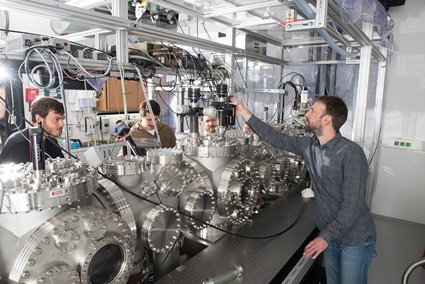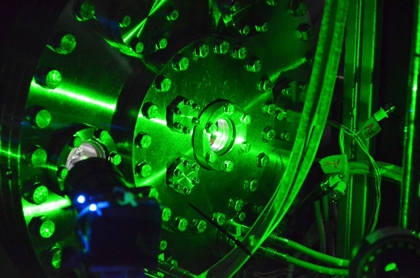|
NOVIDADES
Magnify a speck of dirt a thousand times, and suddenly it no longer seems to play by the same rules. Its outline, for example, won’t look well-defined most of the time and will resemble a diffuse, sprawling cloud. That’s the bizarre realm of quantum mechanics. “In some books, you’ll find they say a particle is in various places at once,” says physicist Markus Arndt of the University of Vienna in Austria. “Whether that really happens is a matter of interpretation.”  To look for the strange wave-like properties of quantum particles, physicists hurtle them through a long tunnel-like instrument known as an interferometer. Photograph: Quantum Nanophysics Group at University of Vienna
But at what size do quantum effects no longer apply? How big can something be and still behave like both a particle and a wave? Physicists have struggled to answer that question because the experiments have been nearly impossible to design. Now, Arndt and his team have circumvented those challenges and observed quantum wave-like properties in the largest objects to date—molecules composed of 2,000 atoms, the size of some proteins. The size of these molecules beats the previous record by two and a half times. To see this, they injected the molecules into a 5-meter long tube. When the particles hit a target at the end, they didn’t just land as randomly scattered points. Instead, they formed an interference pattern, a striped pattern of dark and light stripes that suggests waves colliding and combining with each other. They published the work today in Nature Physics.  Physicists at the University of Vienna keep the inside of their instrument in vacuum and stabilize its exterior so it never moves more than about 10 nanometers. Photograph: Quantum Nanophysics Group at University of Vienna
 The researchers propel the molecules through the interferometer using green laser beams. Photograph: Quantum Nanophysics Group at University of Vienna
To perform the experiment, Arndt’s team used a green laser to launch the molecules into the tube. The molecules absorbed the energy from the light to propel them forward. Then, the molecules passed through a sequence of metal grates containing thin, nanometers-wide slits. The grates effectively divide a single molecule into multiple waves traveling in different directions and recombine them in the end to form the interference pattern. It’s a dressed-up version of the famous double-slit experiment, “one of the hallmark demonstrations of the wave nature of matter,” says Kovachy. They also took great pains to design the optimal type of molecule for in the experiment. Eventually, they settled on a synthetic behemoth with the chemical formula, C707H260F908N16S53Zn4. Its structure was sturdy enough so that its peripheral atoms wouldn’t fall off during launch. It also contains a core assortment of atoms called a porphyrin, which absorbs green light to act as the molecule’s motor. Now, Arndt’s team plans to run this experiment for even more massive objects. They want to test whether they can observe wave-like properties in metal nanoparticles ten times heavier than their bespoke molecule. Eventually, researchers are working toward creating wave-like interference in objects even closer to the macroscopic realm. “Can we do this for a virus? A bacteria? You can keep scaling up,” says Kovachy. Quantum mechanics has inserted a tiny alien world into ours. By doing these experiments, physicists hope to find the seam where the two places meet. By Sophia Chen. Wired: Sept. 23, 2019. |
|||||||||||||||||||||||||